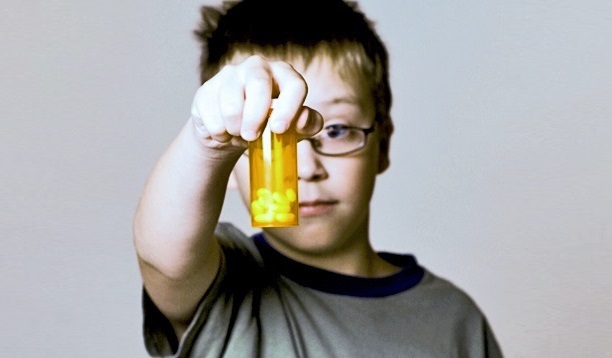Contributing Writer for Wake Up World
The diagnosis and subsequent medicating of children with attention deficit hyperactivity disorder (ADHD) has jumped to alarming levels in the United States over the last few years. The stimulants used to treat the condition have more than doubled since 2007 to an astounding $9 billion in 2012. In light of this, many are questioning whether children are diagnosed accurately or if this is yet another medical label that pharmaceutical companies can exploit to reap massive profits.
To date, 1 in 5 high school aged boys are diagnosed with ADHD, while 1 in 10 are said to have the condition across all age groups below eighteen. According to data collected in 2013 from the Centers for Disease Control and Prevention (CDC), it’s estimated 6.4 million children in the U.S. aged 4 through 17 have received an ADHD diagnosis at one point during their lifetime, which equates to a 16 percent increase since 2007 and a 41 percent jump over the last decade. “Those are astronomical numbers. I’m floored,” Dr. William Graf, a pediatric neurologist in New Haven and professor at the Yale school of Medicine, told the New York Times.
What exactly is going on?
Normal Childhood Behavior or Questionable Pharmaceutical Intervention?
ADHD is classified as a chemical imbalance in the brain which negatively impacts impulse control and attention. Historically, the disorder affects between 3 to 7 percent of children. There isn’t a definitive test for diagnosis — instead, the condition is determined by subjective evaluations from teachers, parents and the child’s physician. Children as young as two-years-old are being diagnosed and prescribed stimulants like Adderall, Ritalin, Concerta and Vyvanse, which carry a laundry list of side-effects such as loss of appetite, sleep disruption, mood swings and poor growth.
Where do we draw the line between normal (if challenging) childhood behavior and a serious medical condition that demands treatment?
Says Dr. Jerome Groopman, professor of medicine at Harvard Medical School and author of How Doctors Think:
“There’s a tremendous push where if the kid’s behavior is thought to be quote-unquote abnormal — if they’re not sitting quietly at their desk — that’s pathological, instead of just childhood.”
The situation is further complicated by the incessant advertising of pharmaceutical companies, who create fear in parents by portraying an unruly, socially unacceptable child with poor performance, then provide a solution in the form of a ‘miracle’ pill — for a price, of course. The CDC estimates the annual societal “cost of illness” for ADHD is between $36 and $52 billion in 2005 — approximately $12,005 to $17,458 annually per individual. [source]
Let’s not forget the drugs prescribed for ADHD are controlled substances — amphetamines, which, as this study shows, function exactly like methamphetamine in the body. So we are essentially medicating our children with the pharmaceutical equivalent of the notorious street drugs speed and crank (meth). This has led to a booming black market for the medication on college campuses as well as in corporate board rooms — really, any place where people need high energy, focus and performance. Adult abuse of ADHD drugs now tops opiates as the number one drug for admission into rehab hospitals in California.
As noted by the New York Times:
“There’s no way that one in five high-school boys has ADHD,” said James Swanson, a professor of psychiatry at Florida International University and one of the primary ADHD. researchers in the last 20 years. “If we start treating children who do not have the disorder with stimulants, a certain percentage are going to have problems that are predictable — some of them are going to end up with abuse and dependence. And with all those pills around, how much of that actually goes to friends? Some studies have said it’s about 30 percent.”
Still, parents and teachers have noticed an uptick in disturbing behavior at home and in the classroom. Even if children don’t fit into the classic model of ADHD with a true chemical imbalance, many are unconvinced this is simply normal childhood behavior. Some believe environmental factors are at play.
Modern Lifestyle and the Rise of ADHD Symptoms
Katie Singer is a medical journalist and advisor for the Electromagnetic Radiation Policy Institute. She’s observed firsthand the effects electromagnetic radiation from Wi-Fi, cellular phones and other wireless technology can have on children.
“Like mobile phone signals, Wi-Fi signals can also cause cell membranes to leak and calcium ions to flow through them in a relatively uncontrolled manner. In the classroom, this may result in children’s brains losing the ability to concentrate,” said Singer.
Moreover, electromagnetic radiation may also inhibit melatonin production, which in turn interferes with normal detoxification and sleep. Since heavy metal toxicity is a growing concern, especially for those with any type of behavioral issue, exposure to wireless technology can aggravate the condition by hindering detoxification pathways. Many families have found that limiting exposure to Wi-Fi, cordless phones and cell phones has significantly improved behavioral issues. Several case studies are available here.
Fluorescent lighting can also be problematic. Victoria L. Dunckley M.D. recommends switching out compact fluorescent bulbs for incandescent or halogen. Why? Because fluorescent bulbs flicker, which triggers a nervous system stress response and negatively impacts sleep — causing a cascade of side-effects relating to emotional regulation, memory, immunity, hormonal balance and repair mechanisms.
And then there is diet. We cannot expect children to focus and sit still if they are pumped full of refined sugar, genetically modified organisms, pesticides, monosodium glutamate (MSG), artificial colorings, additives and preservatives. Additionally, research has shown that those with depleted levels of zinc, copper and iron are more prone to displaying ADHD characteristics. An organic, whole food diet — absent of common allergens like gluten and casein — can go a long way in addressing behavioral problems.
Pine Bark Extract — A Natural Solution?
Lastly, if addressing environmental factors and cleaning-up the diet doesn’t soothe ADHD symptoms completely, follow the lead of European countries and try Pycnogenol. Derived from French maritime pine bark, the extract has been shown to decrease hyperactivity while improving concentration and attention. As a potent antioxidant, pine bark extract helps to minimize the oxidative stress associated with ADHD. In fact, research has found that after taking Pycnogenol for one month, the oxidative imbalance in children with ADHD was resolved, leading to improved cognitive function. [source]
Article sources:
- www.cdc.gov/nchs/slaits/nsch.htm
- www.apa.org/monitor/2014/04/adhd.aspx
- www.cdc.gov/ncbddd/adhd/data.html
- www.nytimes.com/2013/04/01/health/more-diagnoses-of-hyperactivity-causing-concern.html
- www.huffingtonpost.com/larry-diller/adderall-abuse_b_5101278.html
- www.jstage.jst.go.jp/article/jpa/24/1/24_1_41/_article
- www.psychcentral.com/lib/side-effects-of-adhd-medications
- www.onlinelibrary.wiley.com/doi/10.1111/jcmm.12088/full
- www.electronicsilentspring.com/calming-behavior
- www.ncbi.nlm.nih.gov/pubmed/16699814
- www.althealthworks.com/7958/this-plant-can-be-the-next-natural-adderall-substituteyelena
Previous articles by Carolanne Wright:
- Considering the Flu Shot? Here are Five Reasons to Think Twice
- Dr Sebi: The Man Who Cures Aids, Cancer, Diabetes and More
- Plastic-Eating Mushroom Discovered in the Amazon Rainforest — A Solution for Our Trash Saturated World?
- Chronic Lyme Disease: A Modern Plague the Government Chooses to Ignore
- Big Pharma and Organized Crime — They are More Similar Than You May Think
- Over 100 Scientific Studies Agree: Cannabis Annihilates Cancer
- Emotional Energetic Healing: The Future of Medicine is Here
- Why Every Parent Should Consider Unschooling
- The Greenhouse of the Future: Grow Your Own Food Year-Round With This Revolutionary System
- First U.S. City Produces More Electricity Than It Uses — With 100% Renewable Technology
- Autistic Boy with Higher IQ Than Einstein Discovers Gift After Removal from State-Run Therapy
About the author:
I’m Carolanne — a writer, chef, traveler and enthusiastic advocate for sustainability, organics and joyful living. It’s good to have you here. If you would like to learn more, connect with me at Thrive-Living.net or visit Twitter.com/Thrive_Living.

If you've ever found value in our articles, we'd greatly appreciate your support by purchasing Mindful Meditation Techniques for Kids - A Practical Guide for Adults to Empower Kids with the Gift of Inner Peace and Resilience for Life.
In the spirit of mindfulness, we encourage you to choose the paperback version. Delve into its pages away from screen glare and notifications, allowing yourself to fully immerse in the transformative practices within. The physical book enriches the learning process and serves as a tangible commitment to mindfulness, easily shared among family and friends.
Over the past few years, Wake Up World has faced significant online censorship, impacting our financial ability to stay online. Instead of soliciting donations, we're exploring win-win solutions with our readers to remain financially viable. Moving into book publishing, we hope to secure ongoing funds to continue our mission. With over 8,500 articles published in the past 13 years, we are committed to keeping our content free and accessible to everyone, without resorting to a paywall.










